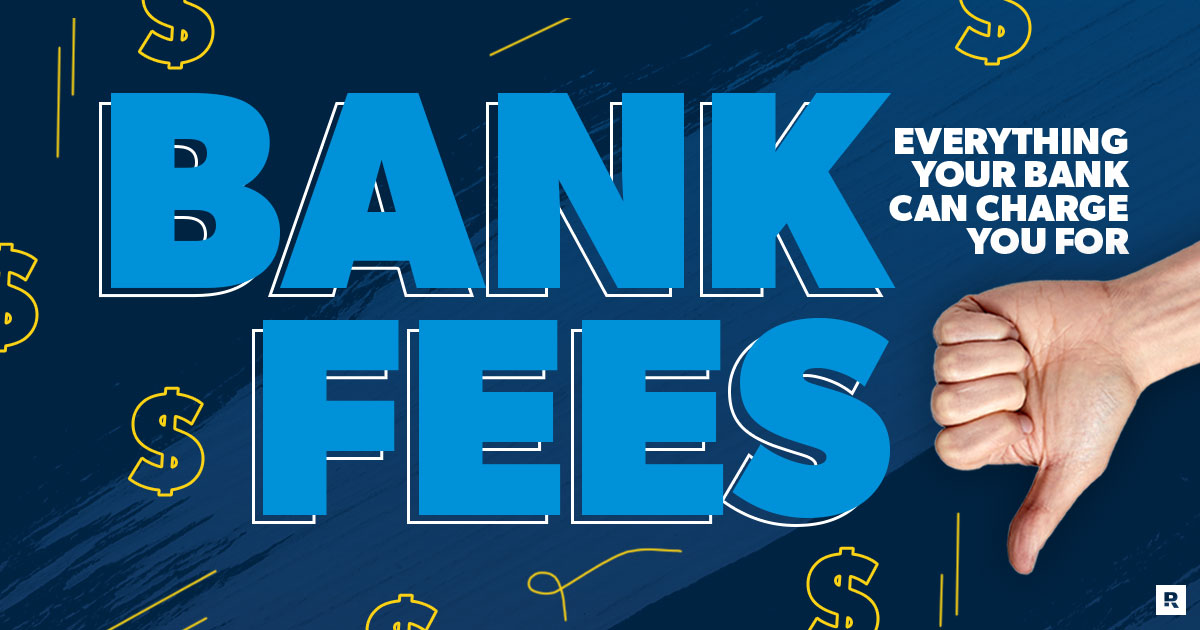You’ve probably experienced the pain of a bank fee at some point—the unexpected charge to your account, the balance that’s lower than it should be, the confusion about why you were charged, the sick feeling of losing money when you were already running short.
If those fees feel unfair, it’s because they are! But why do banks even charge these ridiculous fees? Let’s get into that and learn exactly what they charge you for (which can be pretty much anything) and how to avoid them.
What Are Bank Fees?
Most banks make a lot of money loaning customers’ deposits out and collecting interest on those loans. But that isn’t enough for them. Some particularly greedy banks charge endless fees to nickel-and-dime and suck the life out of the customers (that’s you!) who make those huge profits possible.
These annoying fees can be charged for anything and everything—and they can be a one-time charge or a regular occurrence. By law, banks have to tell you about their fees in all that wonderful fine print they churn out when you sign up to open an account. We know it’s a drag, but it’s super important that you read all (yes, all) the materials your bank gives you to really see what they plan on charging you.
Rather scroll through a screen instead of pages of paper? The bank’s website should also list all its fees.
Types of Bank Fees
Even if a bank lists all its fee types in the fine print and on its website, that doesn’t make charging fees right or fair. In fact, many of the charges are downright dumb. Here are some of the most ridiculous bank fees out there so you’ll know what to watch out for:
Service Fees
Service fees can be applied to checking or savings accounts, and essentially, you get charged for keeping the account open. Yep . . . that’s it. You’re giving the bank money just for storing your name and deposit amount in its computer system.
You might think that sounds fair. After all, you’re paying for the service—storing your money for you. But remember, the bank’s already getting something in return for that. It’s lending out your money and turning a profit from it.
Service fees are a total scam. Don’t give the bank a double payday by letting it charge you a service fee too. It’s unnecessary, and plenty of banks don’t charge these fees. Work with those banks instead!
Maintenance Fees
Maintenance fees are some of the sneakiest ones out there. Service fees can be applied to checking or savings accounts, and essentially, you get charged for keeping the account open.
That’s because your ability to avoid maintenance fees depends on rules the bank sets, like linking your checking and savings accounts, spending a specific amount of money, or keeping a minimum balance in your account. If you don’t meet one of those standards—bam! You just got fee’d!
Maintenance fees can run as much as $25 a month, and they usually fall into two categories:
Inactivity Fees
This is one of the stupidest fees ever. Inactivity fees happen when you aren’t using your account “enough” . . . according to the bank. Since you’re not spending money, the bank spends it for you—by taking it out of your account!
Traditional banks claim they have to charge inactivity fees to keep the account open when you’re not using it. But the truth is, they have to maintain customer accounts whether they’re in use or not. Banks just charge this fee because they’re money-grubbing buzzards who are trying to take your cash—not protect it.
Minimum Balance Fees
This one’s super fun too. We’re sorry . . . did we say “fun?” We meant “dumb.”
Budget every dollar, every month. Get started with EveryDollar!
Most bank accounts (including money market accounts) have a minimum balance, meaning you have to keep a certain amount in the account at all times. If the minimum balance for your savings account is $300 and you’ve got more than that in the account, you’re good.
But let’s say you go under that amount. The electric bill was higher than you expected, your kid needed a sports uniform, or you just had to have a king-size Snickers from the gas station.
Now you’ve got $298 in your account. You’re $2 below the minimum, so the bank charged you $15. That drops your balance to $283. If you don’t notice you’re below the minimum—which is easy to do because, hey, you’re busy—the bank will keep taking $15 out of your account every month until there’s nothing left.
This doesn’t make any sense! The bank is punishing you for not having enough money in your account by taking more money out of it!
That jacked-up logic proves two things: 1) Banks are not your friend and 2) you need to check your account at least once a week to make sure they’re not taking advantage of you.
There is a way to avoid these fees though. You can set up alerts that let you know when your account balance is getting low . . . if your bank gives you that option. If it doesn’t, run! It’s not even giving you a sporting chance to avoid the fees, and that’s just wrong. You can find a better bank than that.
Overdraft Fees
Banks and credit unions made over $8.5 billion on overdraft fees in 2021.1 These fees seem like such a fact of life to most people that it’s easy to forget they weren’t always considered normal. Past generations (think your grandparents or great-grandparents) lived in a world where they either had the money to buy something or they didn’t. No money meant no purchase. End of story.
Banks created overdraft fees because they realized many adults still had a red-faced grocery store kid inside them. You know, the kid who’s throwing a temper tantrum over a toy and his mom gives in just to shut him up. It’s the kid we all stare at and think, What a spoiled brat!
But even if we don’t want to admit it, most of us still have that kid in us. When we want something, we want it now.
Banks know this, so they invented overdraft fees to make money off of it. They tell our immature inner child, “Sure, we’ll buy the $50 thing for you. You can pay us back.”
When you pay them back the $50, they add a $35 overdraft fee. So you spend $85. For that price, you could have had two of what you wanted and still had some money left over—and the bank wouldn’t be taking advantage of you.
Some people try to avoid overdraft fees with overdraft protection. That’s when you link your bank accounts so that the bank will transfer money from one account (usually your savings) to cover the cost if you spend too much money from another account (usually your checking).
But the more money you take from your savings, the more likely you are to start racking up minimum balance fees. Some banks even charge a fee for the “protection” they provide (though it’s usually less than an overdraft fee). And that means less money you have to spend if you have a financial emergency.
Even worse is a type of overdraft protection that links to a line of credit (translation: debt). If you overdraw your account, the bank automatically makes a deposit from the line of credit to cover the amount, usually rounded up to the nearest $100. It’s really gross, and if you’re working on getting out of debt, it will only make your hole deeper.
Bottom line: This “protection” doesn’t really protect you—it costs you. The is only way to truly avoid overdrafts: Control. Your. Spending. Because the truth is, children do what feels good. Adults come up with a plan and follow it.
Now, we know overdrafts sometimes happen when you’re trying to pay bills. We get it. Making ends meet is stressful, and bank fees don’t help. But you can still take control of your money and create a budget that works for you so you never have to pay an overdraft fee again.
Insufficient Funds Fees
If the bank does block a purchase you can’t afford, you may not be out of the woods yet. You’ll pay an insufficient funds (NSF) fee if you opted out of overdraft protection or if you try to spend more money than the protection will cover.
Basically, since you don’t have enough money for whatever you tried to buy, the bank won’t let you buy it. Then, it’ll use the NSF fee to take the money you do have (because that makes sense).
NSF fees cost about the same as overdraft fees, and they can happen with debit cards or checks. Checks are less common these days, but if you do bounce one, it can cause some big problems—like getting in trouble with law enforcement.
Avoiding these fees is extra important for staying out of trouble and keeping your financial integrity in one piece.
ATM Fees
Sometimes you have plenty of money but you access it “wrong.” When you use an ATM that doesn’t belong to your bank’s network, the bank that owns the ATM charges you a fee. And if you’re really (un)lucky, your bank will charge you another fee on top of that.
Of course, there are legit reasons for some of the ATM fees: network processing costs, risk and fraud coverage, physical rent of the ATM’s location, security services to stock and transfer the money, and so on. Sure, running an ATM isn’t free, but that doesn’t mean the fees need to be over the top.
Many people think ATM fees aren’t a big deal because they only cost a few dollars. But when you make a habit of using out-of-network ATMs, that $2.50 to $5 (or more) per transaction adds up.
ATM fees come up a lot when people travel. You know . . . when you find that perfect handmade souvenir to remember your trip but the merchant only takes cash. You then realize you don’t have enough cash, and your bank doesn’t have any local branches. Even big national banks may not have branches in every state or city.
You can avoid some ATM fees by checking online or in your banking app beforehand. There might be a location you didn’t know about or an affiliate bank that won’t charge you. That said, it’s good to have a backup plan—either a debit card or cold hard cash (we prefer the cash, and so do most businesses . . . it’s a universal language).
Transaction Fees
Certain types of transactions are riskier for banks than others, or they require more effort from the bank. In those cases—you guessed it—banks charge fees.
Wire Transfer Fees
When you send someone money, the bank is basically acting as a courier service to make sure the money gets there. So it charges you a fee for that service—usually about $20.
Since international wire transactions pose more risk of loss or fraud, banks charge higher fees when you send money out of the country. International wire transfer fees can cost up to twice as much as domestic transfer fees.
And now a quick time-out for a safety tip: Never send money to anyone unless you know exactly who they are and where the money is going. A lot of kind, well-meaning people become victims of fraud, extortion and identity theft because they were trying to help someone they didn’t know and shouldn’t have trusted. Don’t let that be you!
International Transaction Fees
You may also have to pay foreign transaction fees if you use your debit card or buy certain products while you’re visiting another country. Banks view these transactions as higher risk than buying something at your favorite local store.
One way around international transaction fees is to carry cash. In most destinations, carrying cash is safe as long as you use common sense and don’t flash wads of money in front of people.
Tired of Too Many Fees?
The point is banks like to charge for everything. Remember, banks exist to make money, and one of the ways they do that is by taking yours. And while there are understandable reasons to charge some of the fees, there are others that are overkill. We’ve covered the most common fees, but there are a ton of other fees banks can get you with. So be sure to read your account agreement information and be aware of all the fees your bank charges.
Bank on Your Budget
The best way to control your money is with a budget. Sign up for EveryDollar and start today–for free!
Sign Up
Read the full article here

















